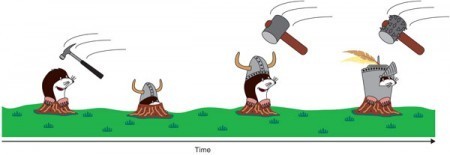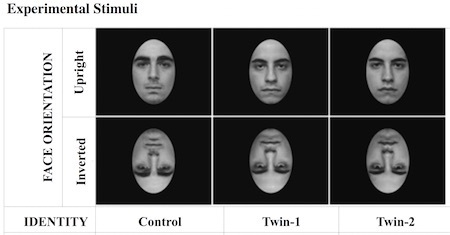Marc Abrahams's Blog, page 335
April 13, 2015
A(nother) new kind of underpants (US patent)
UK-based inventor Paul O’Leary has received (as of 20th Jan 2015) a US patent for his ‘Underwear Garment’
“A significant amount of effort has been expended into research of clothing and, in particular, the aspects of underwear garments which help to promote confidence and self-esteem within a wearer. Such research and development has typically centred on specific areas of the human body, such as the chest or legs, resulting in a number of improvements in the form and function of, for example, brassieres, corsets and stockings. It is perhaps fair to say that less effort has been generally expended in this regard to the groin region.
There are a number of problems and social stigmas associated with the groin region which can lead a person to lack confidence or otherwise feel embarrassed.”
The new invention – already being marketed under the tradename ‘Shreddies’ – is designed (amongst other things) to attend to some of these problems by filtering out flatulence via a ‘Zorflex’ activated-carbon back panel.
The Science Behind Shreddies is explained here : [scroll about halfway down the page]
Also see: A new kind of underpants (2010)
Coming Soon: Underpants in Academia

How to write an “editor’s note” (about nudie musicals in 1970s New York City)
A good editor’s note clarifies something vital that some readers might (without guidance from the editor) overlook or under-appreciate, or that some lawyer insists on having stated explicitly. New editors can learn the art of writing editor’s notes by studying classic examples. Here is one such example:
[Editor’s note: This post contains numerous hyperlinks to video and sound files that enrich the text with excerpts from the films and productions that the author discusses. We suggest that you read through the post once without clicking the hyperlinks to get a sense of their context in the discussion, and then go back through to reap the benefits of these additional illustrations.]
That note appears at the very beginning of an essay called “Nudie Musicals in 1970s New York City“, by Elizabeth L. Wollman [pictured here], associate professor of music at Baruch College, City University of New York. The essay was published on June 16, 2014, in the “Sound Matters” blog, produced by the Society for Ethnomusicology.
(Thanks to investigator Jim Cowdery for bringing this to our attention.)
BONUS: Baruch College is home to many great essayists. Perhaps the greatest is Professor John Trinkaus, who has written nearly 100 studies about things that annoy him.

April 12, 2015
Of Sketchy Perception in a Monty Python Sketch
Not noticing something that’s right before your eyes? Happens all the time. The phenomenon fueled the 2004 Ig Nobel Prize-winning invisible-gorilla research of Americans Chris Chabris and Dan Simons. Now, two researchers in the UK point to a stark example in a Monty Python sketch:
“And now for something completely different: Inattentional blindness during a Monty Python’s Flying Circus sketch,” Richard Wiseman and Caroline Watt, i-Perception (2015) volume 6, pages 38–40. The authors, at the University of Hertfordshire and the University of Edinburgh, explain:
Perceptual science has frequently benefited from studying illusions created outside of academia. Here, we describe a striking, but little-known, example of inattentional blindness from the British comedy series “Monty Python’s Flying Circus.” Viewers fail to attend to several highly incongruous characters in the sketch, despite these characters being clearly visible onscreen. The sketch has the potential to be a valuable research and teaching resource, as well as providing a vivid illustration of how people often fail to see something completely different….
Despite widespread interest in inattentional blindness, most researchers are unaware that a striking example of the phenomenon appears in the British comedy series “Monty Python’s Flying Circus.” Episode 12 of the second series of Monty Python’s Flying Circus aired in December 1970 contained a short sketch entitled “Ypres 1914—Abandoned.” This sketch takes place during the First World War, and begins with a close-up image of a harmonica being played by a British soldier (Eric Idle). The camera then slowly zooms out to reveal four soldiers (including John Cleese, Eric Idle, and Michael Palin) sitting in an army encampment. Standing behind them are several actors dressed in a series of highly incongruous costumes, including that of a nun wearing a large white hat (Graham Chapman), a sheikh, and a Greek Orthodox priest….
Here’s the Monty Python sketch itself, with an added layer of meaning (a narrator, speaking in Polish):

Whack-an-E. coli with the Morbidostat
E. coli figure prominently and violently in this study:
“Whack-an-E. coli with the Morbidostat,” Ofer Fridman, Amir Goldberg and Nathalie Q Balaban, Genome Biology, 2012 Jan 27;13(1):140. The caption to figure 1 of the paper reads:
“The morbidostat, as a whack-a-mole game, maintaining constant evolutionary pressure despite the evolution of protective mechanisms. An Escherichia coli culture is monitored for growth over time. As soon as the culture has grown to exceed a threshold optical density, an antibiotic pulse is added (shown as a hammer whack). If a mutation results in protection from the antibiotic (shown as a protective hat), the antibiotic level is again increased by the computer‑controlled morbidostat. As the bacteria develop more protective mechanisms (stronger helmet), the antibiotic level is further increased (heavier/nastier hammer).”
 BONUS: Video of a traditional Whack-a-Mole game. The man shown here may not realize that he is almost certainly whacking e. coli that are on the moles, as well as whacking the moles:
BONUS: Video of a traditional Whack-a-Mole game. The man shown here may not realize that he is almost certainly whacking e. coli that are on the moles, as well as whacking the moles:

April 11, 2015
How to hold a stick, geologically
In this photo, geologist Ian West demonstrates how to hold a stick:
West is pointing the stick at some of the geology on display at Lyme Regis Westward, on the Wessex coast of southern England.

Chemistry perfume PR innovation: In the future, “better” means “more”
Under a new interpretation — call it, perhaps, “The Belfast Interpretation” — more means better.
To see how this works, read a publicity release issued by Queen’s University Belfast with the headline “Queen’s scientists develop first perfume which smells better the more you sweat“:
Researchers in the Queen’s University Ionic Liquid Laboratories (QUILL) Research Centre have developed a unique new perfume delivery system which releases more of its aroma when it comes into contact with moisture, meaning a person smells nicer when their sweat levels increase.
The laboratory, QUILL, features atop its web site the proud slogan “Rewriting the Future of Chemistry“:
The new interpretation of “more” is being adopted widely, as news reporting about science becomes better and better.
BONUS (unrelated): Another, different science interpretation named after a city: the Copenhagen Interpretation.

Effect of microwave ovens on astronomy
“Rogue Microwave Ovens Are the Culprits Behind Mysterious Radio Signals” is the headline on Nadia Drake’s article in the Phenomena blog. Drake writes:
if you happen to be reheating your coffee at the Parkes Observatory in Australia, you could be contributing to the growing collection of mysterious radio signals known as perytons. Well, the collection of formerly mysterious radio signals: A study posted to the arXiv on April 9 identified microwave ovens at the Parkes site as the rather mundane source of perytons.
“It was quite surprising that it ended up being microwaves,” says study author Emily Petroff [pictured here] of Australia’s Swinburne University of Technology.
For years, astronomers had been puzzled by these brief but intense bursts of radio waves that in some ways appeared to be coming from deep space. There have been dozens of reported perytons, some dating back to the 1990s… perhaps unsurprisingly in retrospect, the peryton data show those signals “clustering near the lunchtime hour.”

April 10, 2015
The former football player, the gay bomb, and Satan
An American former pro football player, now turned radio talk show host, has been consulted about the Ig Nobel Prize-winning research on the so-called “gay bomb”.
In 2007, the Ig Nobel peace prize was awarded to the Air Force Wright Laboratory, Dayton, Ohio, USA, for instigating research & development on a chemical weapon — the so-called “gay bomb” — that will make enemy soldiers become sexually irresistible to each other. [For details of that research, see the report: “Harassing, Annoying, and ‘Bad Guy’ Identifying Chemicals,” Wright Laboratory, WL/FIVR, Wright Patterson Air Force Base, Ohio, June 1, 1994.]
The Raw Story web site reports:
On the Family Research Council’s Washington Watch, host Craig James took a call from a listener who asked him if it was possible that the Pentagon had secretly used a “gay bomb” on America, leading to a rise in the number of openly gay people in the country, reports Right Wing Watch.
According to the caller, identified as “Tom,” if you Google “Pentagon gay bomb” you will discover an article stating that the Pentagon was using “certain chemicals and aphrodisiacs to spray — and to put on the soldiers so they are attracted to other men as a weapon in wartime.”
“My question is, and I wonder, did some of those techniques get used on the American people? Just a thought,” Tom asked.
The former NFL running back, turned conservative talk show host, stammered a bit before replying, “I don’t know anything about that. That’s the first I’ve ever heard of it, it sounds kind of out in left field, like you said. It’s out there for sure.”
James then turned the conversation around, blaming the country’s ills on turning away from the Bible.
Craig James — whose full name is Jesse Craig James — shares a name with a great figure in American history. He was recently in the news for identifying Satan as being in league with his (James’s) former National Football League team, the New England Patriots. CBS reports details of that, under the headline “Former Running Back Claims ‘Satan’ Played Role In Patriots Support Of Gay Marriage“.

Things that must be true, apparently
If there’s a study that says so, and a video that says the study says so, it must be true, right? Here’s the video:
That video draws from five studies, says the video’s maker, specifically:
Pelham, B. W., Mirenberg, M. C., & Jones, J. T. (2002). Why Susie sells seashells by the seashore: implicit egotism and major life decisions. Journal of personality and social psychology, 82(4), 469.
http://persweb.wabash.edu/facstaff/ho…
Polman, E., Pollmann, M. M., & Poehlman, T. A. (2013). The Name-Letter-Effect in Groups: Sharing Initials with Group Members Increases the Quality of Group Work. PloS one, 8(11), e79039.
http://journals.plos.org/plosone/arti…
Dyjas, O., Grasman, R. P., Wetzels, R., Van der Maas, H. L., & Wagenmakers, E. J. (2012). What’s in a name: a Bayesian hierarchical analysis of the name-letter effect. Frontiers in psychology, 3.http://journal.frontiersin.org/articl…
Jones, J. T., Pelham, B. W., Mirenberg, M. C., & Hetts, J. J. (2002). Name letter preferences are not merely mere exposure: Implicit egotism as self-regulation. Journal of Experimental Social Psychology, 38(2), 170-177. http://www.sciencedirect.com/science/…
Nuttin, J. M. (1987). Affective consequences of mere ownership: The name letter effect in twelve European languages. European Journal of Social Psychology, 17(4), 381-402.http://onlinelibrary.wiley.com/doi/10…
BONUS: Nominative determinism.

April 9, 2015
Identical twins’ failings at discriminating each other’s faces
Identical twins are no better than outsiders at recognizing photos of each other’s faces when the photographs are upside down, and sometimes when the photos are rightside-up, says this new study:
“Is That Me or My Twin? Lack of Self-Face Recognition Advantage in Identical Twins,” Matteo Martini, Ilaria Bufalari, Maria Antonietta Stazi, Salvatore Maria Aglioti, PLoS ONE 10(4): e0120900. The authors, at the University of Rome “La Sapienza,” IRCCS Fondazione Santa Lucia, Rome, Institut d’Investigacions Biomèdiques August Pi i Sunyer (IDIBAPS), Barcelona, Spain, University of East London, UK, and the National Twin Registry—Italian National Institute of Health, Rome, Italy, report:
Despite the increasing interest in twin studies and the stunning amount of research on face recognition, the ability of adult identical twins to discriminate their own faces from those of their co-twins has been scarcely investigated…. Given the very high level of resemblance of their faces, monozygotic twins represent a unique model for exploring self-face processing….
We devised a task in which monozygotic twins were asked to report by pressing one of three keys whether upright and inverted facial pictures were of themselves or the co-twin. As a control, we also included a non-twin face to test whether twins were better at recognizing their co-twins’ face or another personally well-known face, which was matched as much as possible for familiarity, exposure, and emotional valence….
Twins lack self-face recognition advantage….
The more the twins felt as if they physically resemble each other, the lower their performance at identifying their own face. In other words, sharing highly similar physical features impaired twins’ ability to discriminate the self from the co-twin’s face….

The Twins were better in recognizing the self and co-twin faces with respect to control participants when stimuli were upright ((0.061 ± 0.013) vs. (0.041 ± 0.020); p = 0.002), but performed similarly when stimuli were inverted ((0.040 ± 0,012) vs. (0.033 ± 0.018); p = 0.294))

Marc Abrahams's Blog
- Marc Abrahams's profile
- 14 followers





